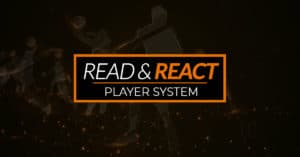If you haven’t read Part 1 yet, Post-Game Analysis, we recommend heading over and reading it before starting Part 2.
One of the famous quotes in coaching is, “Film doesn’t lie”. Meeting with your time and showing them their mistakes on film, rather than trying to explain them, is and will always be one of the most impactful ways you can help your team improve. However, it is only effective if it is done the right way. There are numerous ways to watch film with your team, and those methods can vary greatly depending on the level your program competes at. I am going to share what I have found to be the most effective approach to watching film with our team.
Be Prepared
The most significant piece of keeping your players engaged is to be prepared. This means making sure your computer set-up, projector, tv, however you watch film, is powered on and ready to go when the film session begins. The last thing you want is your team sitting in silence while you try to queue up the film. If you are in a program that has a video coordinator or a coach designated as the video specialist, they should already be in the room preparing the video before the team (especially the other coaches) walk in.
The second aspect is having a game plan for your film session. Have you ever played for or coached with someone whom after a loss especially, would sit and make their players watch the entire game. Meanwhile berating the team for every nonsensical mistake made. While this may be effective for some teams, is it really the best use of your time together as a team? In my opinion, no. I prefer to pick out the clips from the previous game(s) that are teachable moments that our players can learn from; and make sure those clips are marked or in a separate play edit to reference in an efficient manner.
Additionally, place the clips in an order of importance; viewing the essential clips first. We all know that film sessions tend to go longer than expected, especially if there is a lot of teaching taking place and the players are asking questions. If you designate 30 minutes to your film session and only get through half of your plan, by placing the important clips first you ensure that the point(s) you want to emphasize are addressed.
Create Teachable Moments
In addition to having a game plan of WHAT you want to show your players, it is just as important to have a game plan for HOW you want to show it. We can all sit and watch film and tell players what they did wrong and ask rhetorical questions, but again that isn’t the best use of our time. Here’s an example:
You are watching film and in the possession Johnny gets beat to the middle on the dribble, no one else steps up to help, and the opponent scores an uncontested lay-up. Coach yells at Johnny, “JOHNNY! What the heck are you doing? Why’d you get beat middle? You know that isn’t how we guard! What’s wrong with you?…AND SAMMY (Sammy should have been in help side) why weren’t you in help and step-up to help Johnny? I can’t believe how lazy you guys are!”
Sound familiar? I am sure we have all been there or said something like that at one point in our careers. If you haven’t, then you are living life right! Here is how I would handle the same scenario in a film session:
“Johnny, do you see why you were beat middle?” Johnny replies that he was too close to his man. “Johnny yes you could have been too close, but look at your feet, you closed out with an angle inviting your man to dribble middle. Here is where your feet should be angling the ball to the baseline (illustrate with a laser pointer or hand where he should be standing). “Sammy when the ball is here (point to where ball is), and your man is on the weak side, where should you be standing? More times than not this player knows the answer and will say, “On the help line”. As a coach this is another opportunity to ask a rhetorical question such as, “Yeah! Well why weren’t you”. Instead, re-enforce the importance of that player and entire team of being in the correct positions on defense to shrink the floor.
It is especially important when watching film that your players are open to dialogue and are not afraid to speak up or ask questions. There may be a reason they were out of position or made a mistake, let them explain why and talk about it. By creating these teachable moments with your players, not only will they learn and hopefully stop making the same mistake(s), but these moments also go into the process of your players buying into YOU, as a person and a coach.
Power of Positivity
This last section somewhat goes hand-in-hand with Teachable Moments. I am a huge fan of Jon Gordon and his positive lifestyle. Reading his books has definitely helped me not only become a better husband and father, but a better coach as well.
While Gordon preaches positivity as a key to success, he also realizes that being positive 100% of your life is not very realistic. That mindset starts creating a false sense of success and eventually becomes almost counter productive. He recommends a 3:1 Positive to Negative Ratio. For every one negative thought or word spoken, you must reinforce success with that same player with three positive comments. Any more than three positives, the false sense of success starts to creep in and any less than one that same player has a more difficult time seeing success through your coaching.
Keeping that in mind, it is rare that during a film sessions we will actually show three clips of the team performing correctly and one clip showing poor play that needs correction. After all, the point of film sessions is to teach and prevent our mistakes. But I do believe that it is important to establish a balance in one of two ways.
- Create two separate play edits; one showing teachable moments and another displaying the same actions performed correctly. Always show the good stuff second so the players leave the film session with a positive mindset.
- Mix up the teachable moments and correct clips throughout a single play edit. Keep in mind that it is most effective to keep the corrections grouped. If you are showing the team how they kept missing rotations in the press, show several clips immediately afterward of the team performing them correctly (hopefully you have some).
The last piece of positivity surrounds the idea of keeping it a “Team Film Session”, not a film session of personal attacks. Avoid singling players out throughout the entire session and embarrassing them in front of their peers. If you notice a player making the same mistakes over and over and they just aren’t getting it, then it is time to bring them in individually and show them a film edit of just themselves. Click here to read Part 3!







